Introduction and Key Findings
Advocates for criminal justice reform have made significant inroads in the past few years. Measures have been enacted to decriminalize a range of crimes, reduce the punishments for committing crimes, and pursue decarceration through various means. The results of these actions have had a serious and lasting impact on Colorado communities, resulting in increased crime and a decrease in public safety. This report looks at the current state of crime in Colorado through the lens of publicly available data on the level of crime and crime rates.
Crime rates in Colorado continue to top pre-pandemic levels. This year, Colorado’s average monthly crime rate has been 530 crimes per 100,000 residents, with no relief in sight. While slightly lower than last year’s peak, it remains 7.3% higher than in 2019, and 20% higher than in 2008. Incidents of robbery, arson, car theft, vandalism, prostitution, and the purchase of stolen property have continued to increase in 2022. Several violent crimes such as murder, rape, and sexual assault are on pace to be lower than 2021 levels. The most significant decline occurred in fraud due, in large part, to the phasing out of COVID-19 related payments, which had elevated levels of fraud, particularly through unemployment insurance payments.[i]
Compared to other states, Colorado ranks first in motor vehicle theft and second in property crimes. This year, Denver, Aurora, Pueblo, and Westminster ranked among the top ten of 167 American cities surveyed in several crime categories. Pueblo made the top ten in each of 10 categories. Denver’s homicide rate rose even as other major cities’ rates declined.[ii]
The Colorado State Patrol (CSP) is on track to seize 300% more illicit fentanyl this year than last. According to the CSP, the state is experiencing a 10-year drug trafficking record. Although there has been a decrease in cocaine and methamphetamine trafficking, the amounts of fentanyl and illegal marijuana seized have been significantly higher. The increase in fentanyl is alarming, given its potency. As a lethal dose of fentanyl is a mere two milligrams, the 412 pounds seized so far this year is enough to kill 93 million people.[iii] The total number of drug overdose deaths has gone up in each of the past three years and opioids, fentanyl in particular, claimed the most lives.
Concurrent with Colorado’s rising crime rates, since the start of the pandemic, incarceration in Department of Corrections facilities dropped by 15.5%, the number of offenders on parole by 14.1%, and the number of offenders on probation by 14.4%. A rise in crime should catalyze a corresponding rise in arrests, convictions, and incarceration for the sake of public safety and justice for victims.
Key Crime Rate Statistics in 2022
The Colorado Crime Rate
- The number of crimes increased in 7 major categories: robbery, arson, motor vehicle theft, buying stolen property, vandalism, prostitution/pandering, and drug possession/sales.
- Colorado continues to rank 1st in motor vehicle theft in the nation. The motor vehicle theft rate has increased by another 13.6% in 2022. At this rate, car thieves will steal 48,000 vehicles in Colorado this year alone.
- Colorado ranks 2nd in crimes against property in the U.S.
- Cases of fraud declined by 61%, as frauds associated with COVID-19 relief programs receded when the programs ended.
Crime Across Colorado
- Out of 167 cities reporting across the U.S. in the FBI’s 2022-Q2 Quarterly Uniform Crime Report, Pueblo ranks in the top ten rates of crime for all ten crime categories listed: aggravated assault (8th), violent crime (5th), murder (8th), rape (2nd), robbery (4th), property crime (5th), burglary (4th), larceny/theft (7th), motor vehicle theft (6th), and arson (2nd).
- Among 69 major cities surveyed by the Major Cities Chiefs Association in their 2022 Mid-year Comparison with 2021:[iv]
- Aurora ranks 7th in the growth rate of homicides (35% increase), 66th in rape (32.3% decrease), 21st in robbery (21.4% increase), and 5th in aggravated assault (26.7% increase).
- Denver ranks 12th in the growth rate of homicides (23.3% increase), 33rd in rape (3.8% decrease), 36th in robbery (7.3% increase), and 16th in aggravated assault (11.3% increase).
Fentanyl
- In the first five months of 2022, Colorado law enforcement seized more fentanyl (2 million dosage units), than it seized in all of 2021.
- The Colorado State Patrol has seized enough fentanyl this year to kill 93 million people.
- Fentanyl will likely kill over 1,500 Coloradans this year, nearly 500 more than 2021. Between 4 and 5 Coloradans are dying daily from overdosing on synthetic opioids (including fentanyl) on average in 2022. This is up from 2 to 3 Coloradans per day in 2021.
Drug Trafficking
- According to the Colorado State Patrol (CSP), Colorado is in the midst of a 10-year drug trafficking record. Through August of 2022, drug seizures by the Colorado State Patrol are up 173% for fentanyl-bulk (412 pounds), and up 75% for cannabis (4,395 pounds).
- Legal cannabis sales have increased by 166% since 2014. However, sales flattened in 2021 and are beginning to fall in 2022.
- Illegal cannabis seized by the CSP, which is a fraction of the total illegal cannabis seized by law enforcement or even available throughout Colorado, has increased by 1,327%, at least eight times as much as legal sales.
Drug Overdoses
- Comparing Colorado to all other states and the District of Columbia, Colorado now ranks 16th in total overdose deaths, up 7 places from 2021.
- Nearly two-thirds of overdose deaths occur among people between 15 and 44 years old.
- At current rates, 2,000 Coloradans will die from drug overdoses in 2022.
Colorado Crime Rate
As Figure 1 illustrates, despite year-to-year fluctuations, the trend line for the average monthly crime rate per 100,000 residents has increased since 2008. The significant increase in Colorado’s crime rate in 2021 was heavily influenced by a massive increase in COVID-19 relief program frauds. The Colorado Department of Labor and Employment (CDLE) reported in April 2021 that it had uncovered 1.2 million fraudulent claims since March 2020.[v] Many of these programs ended in 2021 and 2022 resulting in a decrease in the number of fraudulent claims. Without these COVID-19 cases of fraud, the crime rate in 2021 would be much closer to the trend growth rate shown by the black line in Figure 1. The blue line is the average monthly crime rate with the COVID-19 fraud cases included.
Figure 1 – Average Monthly Crime Rate per 100,000 Residents in Colorado
Figure 2 shows the change in the crime rate per 100,000 residents for the period of 2019 (pre-pandemic) to June 2022 (blue bars), and from 2021 to 2022 (red bars).
Figure 2 – Percent Change in Crime Rate 2019 (pre-pandemic) to 2022 vs. 2021 to 2022
The crime rates of half of the fourteen major categories of crime continued to increase through June 2022:
- Robbery: 0.2%
- Arson: 5%
- Motor Vehicle Theft: 13.6%
- Buying Stolen Property: 2.7%
- Vandalism: 2.2%
- Prostitution/Pandering: 1.9%
- Drug Possession/Sales: 1.9%
In most categories (9 out of 14), rates remained significantly elevated above pre-pandemic levels:
- Murder: 30.7%
- Robbery: 15.4%
- Assault: 5.9%
- Arson: 56.6%
- Burglary: 3.9%
- Larceny/Theft: 4.5%
- Motor Vehicle Theft: 111.6%
- Buying Stolen Property: 35.2%
- Vandalism: 36.9%
Crime in Colorado Relative to Other States
In 2022, Colorado has seen little movement in the five major crime categories from 2021. Colorado’s rankings compared to all other states are shown in Table 1.
- Colorado remains the number one state for motor vehicle theft.
- Colorado ranks 2nd in crimes against property.
- Colorado moved up to 26th from 27th in crimes against society.
- Colorado’s homicide rank dropped to 21st.

Crime in Colorado’s Cities
Using the latest report from the FBI’s Uniform Crime Reporting Program (UCR) for the second quarter of 2022, CSI converted the number of crimes to crime rates based on population for each reporting city. 150 cities reported to the UCR in Q2 2021 and 167 reported in Q2 2022. Highlighted in Table 2 are Colorado cities that rank in the top ten of the respective crime categories. Denver ranks 2nd in motor vehicle thefts (up from 3rd in 2021). Denver, Aurora, Pueblo, and Westminster held four of the top ten spots for vehicle theft. Pueblo occupies a top-10 spot in each crime category.
Other areas in which Colorado cities rank in the top ten include property crime, violent crime, rape, robbery, burglary, larceny/theft, motor vehicle theft, and arson [vi]
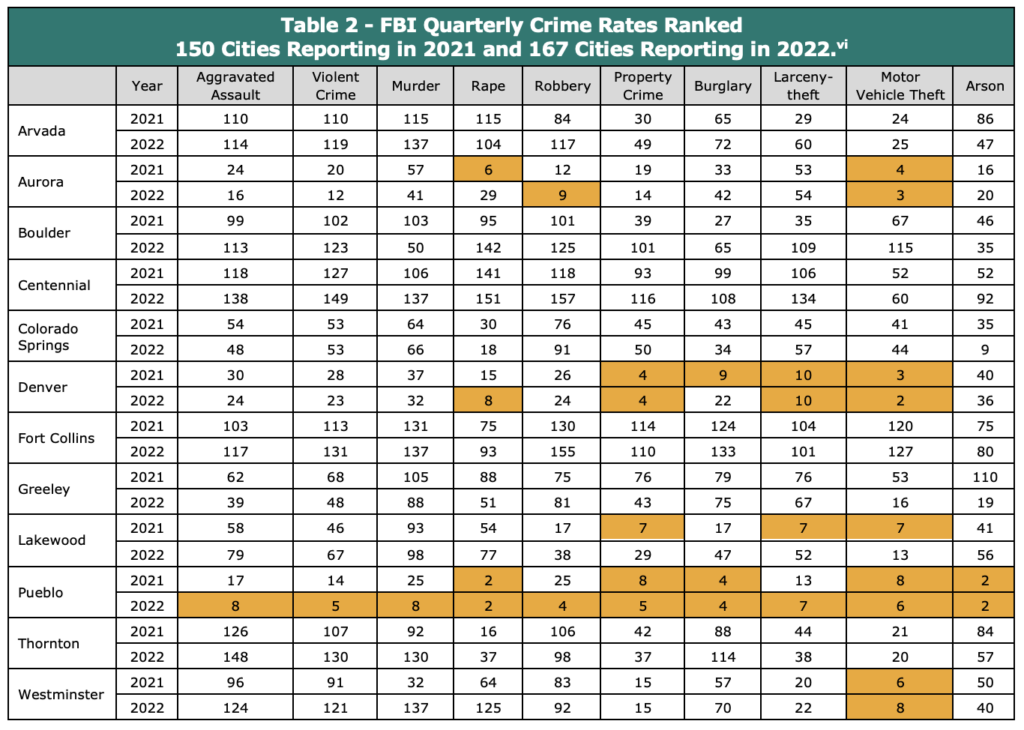
Areas of Concern
Increase in Drug Overdose Deaths
Despite the crime rates for drug possession and sales increasing only 1.9%, the flood of synthetic opioids is taking a significant toll on Colorado families as overdose death rates soar. Citing the latest data from the Center for Disease Control and Prevention, Table 3 and Figure 3 show the numbers of deaths due to drug overdoses in 2019, 2020, and 2021. Year-to-date data for 2022 are unavailable; CSI used the CDC’s 12-month estimates through April to estimate the annual number of deaths in 2022. The total number of drug overdose deaths increased in each of the last three years by 9.6%, 37.5%, and 26.9%, respectively. Overdose deaths increased by 74.4% between 2019 and 2021. If the estimate for 2022 ends up close to the actual number, there will have been a 101.3% increase since 2019. The annual increases are remarkable. Synthetic opioids (T40.4), including fentanyl and tramadol, caused the most deaths of all categories of drugs.

Figure 3 – Deaths Due to Drug Overdoses in Colorado[vii]
Table 4 and Figure 4 show the shares of total overdose deaths per one million residents in Colorado by drug. Both the number and rate of overdose deaths has increased each year. The number of overdose deaths per one million residents has increased by 101% between 2019 and 2022. Estimated deaths due to synthetic opioids (T40.4) such as fentanyl have increased from 44 per one million residents in 2019 to 252 deaths per one million residents in 2022—a 473% increase.
Comparing Colorado to all other states and the District of Columbia, Colorado ranks 16th in total overdose deaths, 18th in synthetic opioids overdose deaths (T40.4), and 20th in all opioids overdose deaths. These ranks are higher than they were before the pandemic by 11 places, 10 places, and 8 places respectively.

Figure 4 – Fatal Drug Overdose Rates Per 1,000,000 in Colorado
Table 5 and Figure 5 show changes in overdose deaths and death rates since 2019. Though year-over-year percentage changes in the number of deaths and the death rate have dropped in each year, they are misleading. The changes in the number of deaths and death rate were so large from 2019 to 2020 that the increases in 2021 and 2022 look small by comparison even though the number of drug overdose deaths has grown each year.
Figure 5 – Year-over-year Fatal Drug Overdose Growth between 2019 and 2022 Est.
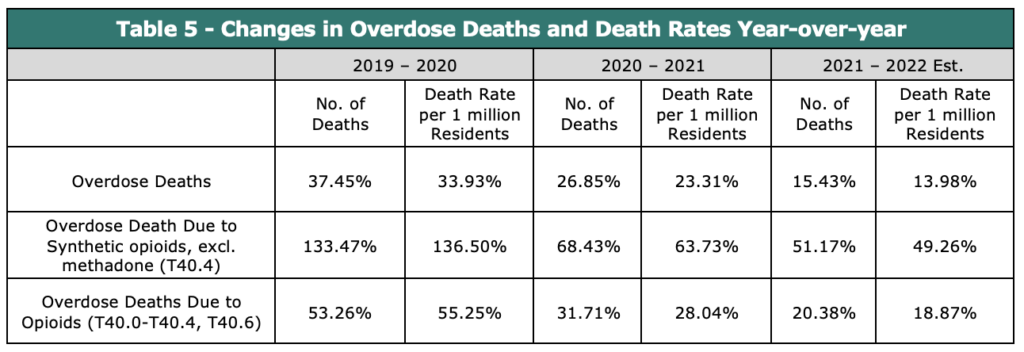
Synthetic Opioid (Class T40.4) Synthetic Opioids, Including Drugs Such as Fentanyl and Tramadol and Excluding Methadone
Drug overdose deaths due to class T40.4 synthetic opioids, which include fentanyl and tramadol, are a majority of all opioid related deaths. They are cheap and abundantly available.
Figure 6 – T40.4 (Synthetic Opioids Including Fentanyl and Tramadol) Share of All Drug-related Deaths and Share of all Opioid Deaths

Fatal Overdose by Age Group and Drug Class
Fatal drug overdoses occur in all age groups as shown in Figure 7. Those between 25 and 34 years of age suffer the highest overdose death rate of all age groups. Although the focus is often on the number of overdose deaths from fentanyl or fentanyl-laced drugs among young people, the data demonstrate that deaths from fentanyl occur at all ages, and that the 25–44 age group is most impacted.
Figure 7 – Death Overdose Rates (per 100,000 Residents) by Age Group and Drug Class Between 2018 and 2020.
Table 7 shows that two-thirds of overdose deaths occur among people between 15- and 44-years-old.
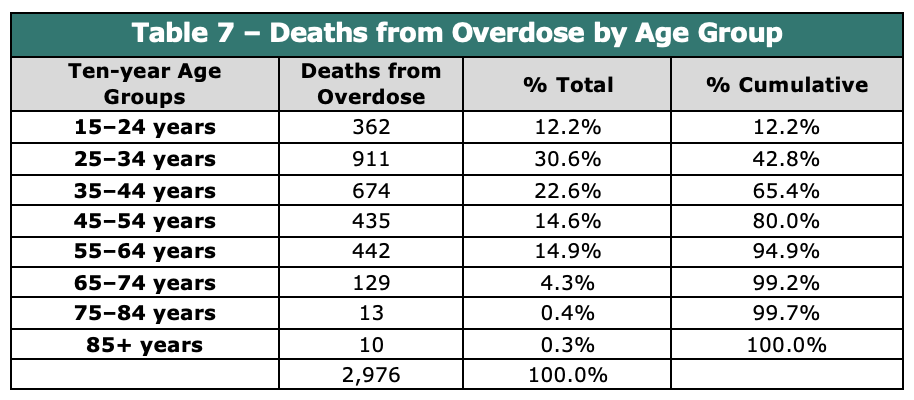
Figure 8 shows the Center for Disease Control’s predicted number of deaths from drug overdoses by class of drug. While deaths from synthetic opioids are growing rapidly, deaths from heroin, natural, & semi-synthetic opioids are decreasing. Deaths from synthetic opioids is growing due to increased availability, low cost, and accidental deaths from opioids like fentanyl mixed with other drugs without the knowledge of the drug user.
Figure 8 – Predicted Number of Deaths from Drug Overdose by Drug Class. (Source CDC.)
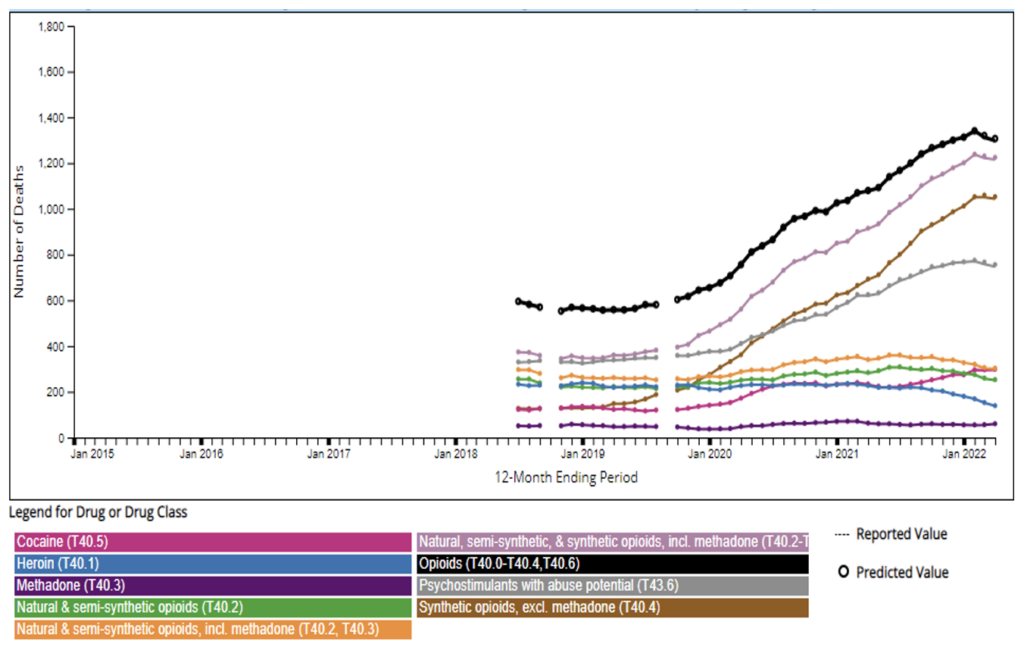
Drug Seizures in Colorado
According to the CSP, Colorado is experiencing a 10-year drug trafficking record.[viii] Using the most recent data available, Table 8 and Figure 9 show the amounts and types of drugs seized by the CSP. Seizures of cocaine, heroin, and methamphetamine decreased, and seizures of fentanyl and marijuana increased.
Fentanyl seizures increased by 173% from 2021 to 412 pounds through August 2022 (618 pounds annualized). According to the Drug Enforcement Agency (DEA), two milligrams of fentanyl is a lethal dosage in most individuals and one kilogram of fentanyl has the potential to kill 500,000 people.[ix] One pound of fentanyl can kill 227,000 people. The potential number of deaths from the seized fentanyl is 93,400,000, or enough to kill every Coloradan 15 times over. If the trend continues, 618 pounds will be seized by the CSP by the end of the year—enough to kill every Coloradoan 23 times over.
Unfortunately, the number of drugs seized by law enforcement personnel is only a fraction of the illicit drugs on the market. In a June 1, 2022, press release, the United States Attorney’s Office – District of Colorado reported that, in the first five months of 2022, the Office seized more than 2 million dosage units of fentanyl—more than they seized in all of 2021. Col. Matthew C. Packard, chief of the Colorado State Patrol, stated, “While I would love to tell you that our troopers have eliminated the threat of this deadly drug, what we remove is a drop in the ocean. It’s cheap, it’s everywhere, including a strong counterfeit market where people think they are taking other forms of pills.”[x]
Because the amount of fentanyl seized represents only a small fraction of the total illicit fentanyl market, the potential number of people who could die from illicit fentanyl is much larger than the predicted number based on known confiscations.
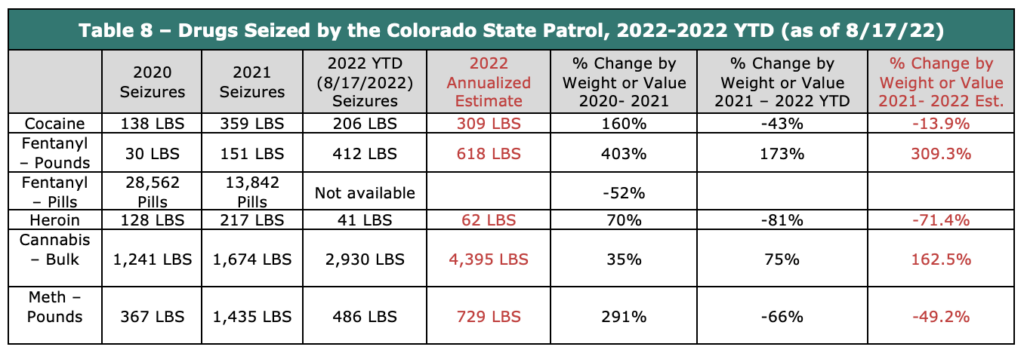
Figure 9 – Drugs Seized by the Colorado State Patrol
Even though cannabis is legal to sell and consume through Colorado’s regulated market, the amount of illegal cannabis seized increased by 35% from 2021 to 2,930 pounds through August 2022 (4,395 pounds annualized). Proponents of legalized marijuana predicted that the legalization would eliminate illegal cultivation, transport, and sale. Despite recreational marijuana’s legalization in 2012, there remains a thriving black market which appears to be growing. After a successful joint operation by the Drug Enforcement Administration and CATPA Metropolitan Auto Theft Task Force (C-MATT) in 2018 took down an illegal marijuana and stolen automobile operation, Special Agent in Charge William McDermott said, “Criminal organizations use the marijuana industry in Colorado to operate not only in black-market marijuana cultivation and distribution, but also many other criminal related activities.”[xi]
Figure 10 describes the sales of legal cannabis and the amount of cannabis seized by the CSP. Sales of legal cannabis have increased 166% since 2014, but, beginning in 2021, sales appear to have peaked and are beginning to fall. Illegal cannabis seized by the CSP, which is only a fraction of the total illegal cannabis available, has increased by at least 8 times as much as the increase in legal sales. Despite claims that legalization of cannabis would shrink the illegal market for cannabis, it appears to have proliferated.
Figure 10 – Sales of Cannabis and Cannabis Seized by the Colorado State Patrol, 2014–2022 Est.
Correctional Population Data
From 2010 to 2019, the total population in correctional facilities remained relatively consistent (30,000 to 31,000 people). From the beginning of the pandemic, however, all categories of adult correctional populations have declined (see Figure 11).
Figure 11 – Colorado Correctional Populations
As Table 9 shows, incarcerations in Department of Corrections facilities dropped by 20.3%, offenders on parole by 14.1%, and offenders on probation by 14.4%.
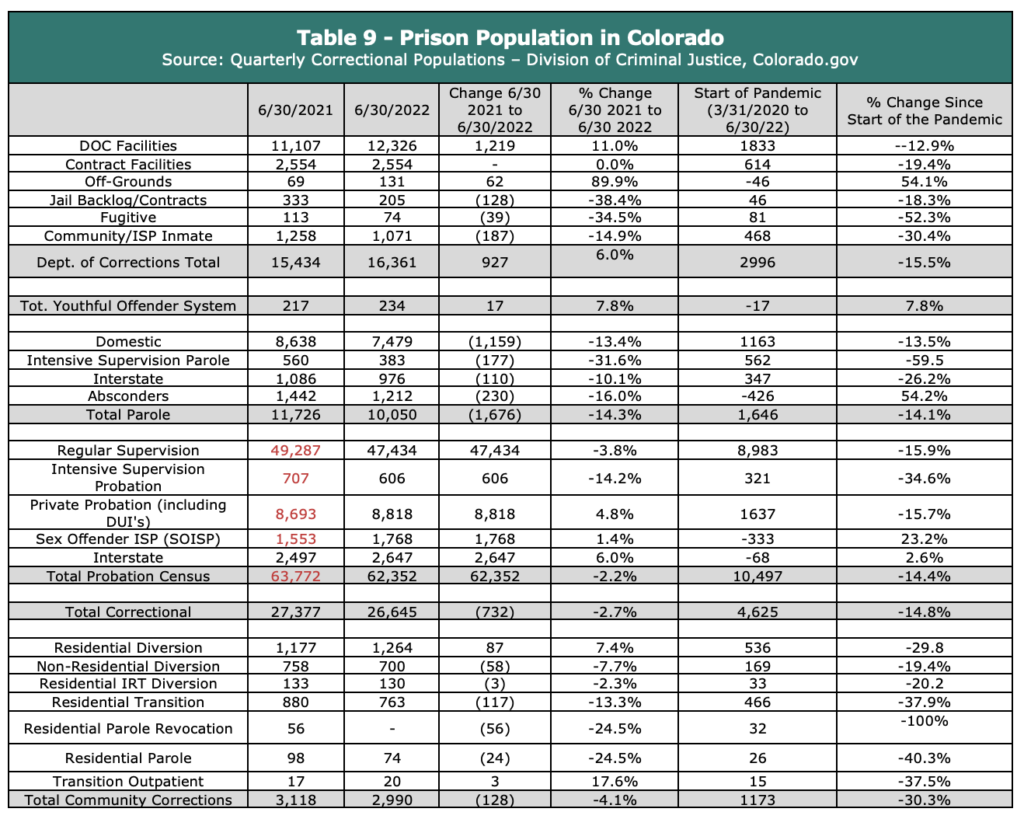
Jail Population
Figure 12 shows an 11.6% decline in Colorado’s total jail population (from 11,698 to 10,337) in Q2 of 2022. Following a 28% drop in Q2 of 2020, the jail population has steadily increased.
Figure 12 – Jail Population
Among the 18 largest county jail populations, which together account for 90 percent of the total population, the jailed population declined in 15 counties. Denver has the largest jail population (16.5% of the state total).
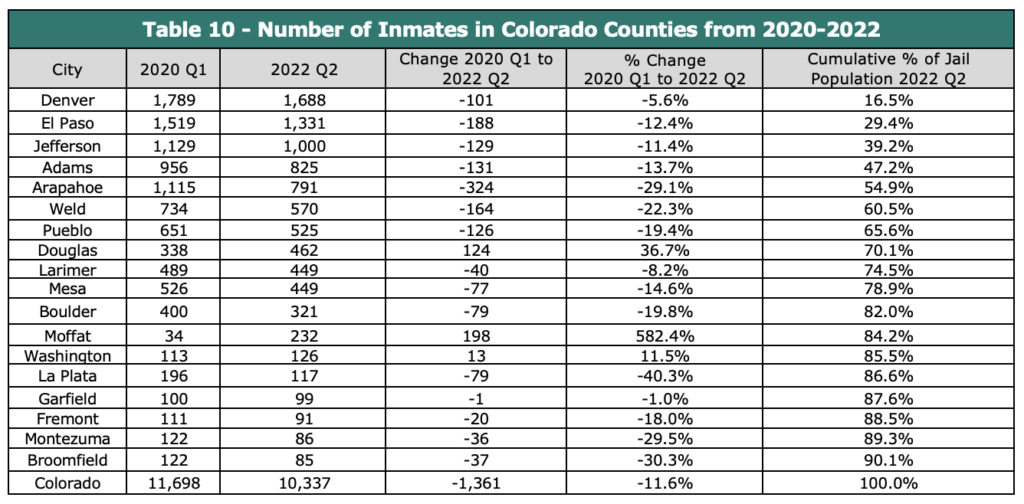
Concluding Remarks & Recommendations
This report is based on crime data that is publicly available and verifiable as of September 2022. The continued increase in crime throughout Colorado is troubling. There seems to be a direct correlation between criminal justice reforms that have made punishments for committing crimes less severe and allowed more criminals back on the streets. Predictably, the number of crimes and crime rates have escalated.
Crime in Colorado has increased substantially since 2008. Over the last 14 years, the overall crime rate has continued its steady and inexorable climb, increasing 1.4% per year on average. Denver, Aurora, and Pueblo, mid-sized cities, rank at the top in several crime categories. Denver’s homicide rate rose this year, even as other major cities have seen declines.
Overdose deaths, fentanyl, have increased. The amounts of fentanyl and marijuana seized by law enforcement have risen substantially. The former’s increase is alarming because of the lethality of the synthetic opioid. The increase of the latter is surprising; proponents of cannabis legalization assured the public that black market marijuana sales would decrease.
Despite Colorado’s rising crime rates, incarceration in Department of Corrections facilities has dropped. Since the beginning of the pandemic, all categories of adult correctional populations have declined.
The public has the right to question Colorado’s persistently high rates of crime and whether policymakers’ decisions have facilitated this crime tsunami. Is the surge in fentanyl related to relaxed penalties? Is there a correlation between the rise in lawless behavior such as vandalism and vagrancy and the rise in serious crime? Why are police departments experiencing staff shortages and low morale? Why has the legalization of marijuana not extinguished the black market and why is illegal marijuana trafficking on the rise? Given the increase in crime, the public should expect an increase in incarceration and yet, the number of incarcerated adults has decreased. Why has it?
In early fall 2022, some elected officials in Colorado began to take steps towards reversing this trend. The City of Aurora has voted to revise auto theft penalties and theft ordinances in an attempt to address crime. The revisions to auto theft penalties includes increased penalties for first-time offenders to a mandatory minimum sentence of 60 days in jail and repeat offenders will be sentenced to a mandatory minimum of 120 days in jail. Revisions to theft include a requirement that people convicted of stealing $300 or more face a minimum 3 days in jail.
Following the recent release of CSI’s report on motor vehicle theft[xii] in early September, Governor Jared Polis penned a letter just a week later, to the Colorado Commission on Criminal and Juvenile Justice calling for increased penalties for people convicted of auto theft. The Commission makes recommendations which the legislature can choose to address but is not required to.
Crime harms individuals and families, devastates communities, and diminishes our state’s economic growth. Trends in crime, drug overdoses, and incarceration of criminals are moving in the wrong directions. The public deserves better.
© 2022 Common Sense Institute
[i] Denver Post, April 18, 2022 “The Big Payout: Fraud was so rampant in Covid relief programs that Colorado still doesn’t know how much was stolen.”.
[ii] https://www.axios.com/local/denver/2022/09/13/denver-murders-rose-2022-major-cities
[iii] Facts about Fentanyl (dea.gov). According to the Drug Enforcement Agency (DEA), two milligrams of fentanyl is a lethal dosage in most people and one kilogram of fentanyl has the potential to kill 500,000[iii]. One kilogram equals 2.205 pounds Therefore, one pound of fentanyl can kill 227,000 people, so the potential number of deaths from just the seized fentanyl is:
- 412 pounds * 1 kg/2.205 pounds * 500,000 people/kg = 93,424,036 people
- Enough to kill every Coloradoan 15 times over.
- 618 pounds * 1 kg/2.205 pounds * 500,000 people/kg = 140,136,054 people
- Enough to kill every Coloradoan 23 times over.
[iv] https://majorcitieschiefs.com/wp-content/uploads/2022/08/MCCA-Violent-Crime-Report-2022-and-2021-Midyear.pdf
[v] Ibid.
[vii] Products – Vital Statistics Rapid Release – Provisional Drug Overdose Data (cdc.gov)
[viii] CSP 2021 Annual Report (colorado.gov)
[ix] Facts about Fentanyl (dea.gov)
[x] https://www.justice.gov/usao-co/pr/fentanyl-seizures-first-five-months-2022-surpass-all-2021
[xi] Denver DEA and Auto Theft Task Force take down black market marijuana & auto theft ring
[xii] Microsoft Word – CSI_CO_REPORT_CAR THEFT_FINAL.docx (commonsenseinstituteco.org)

